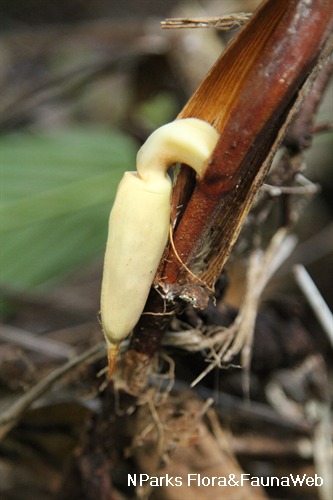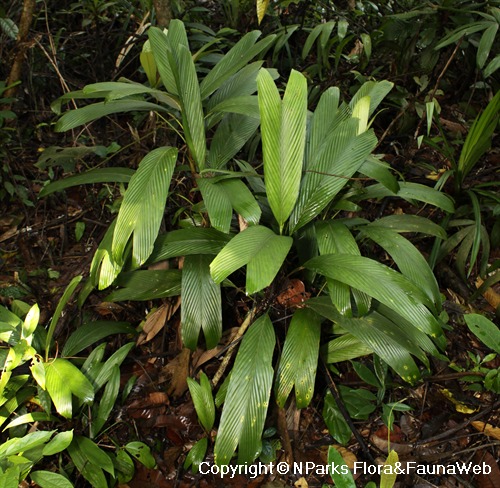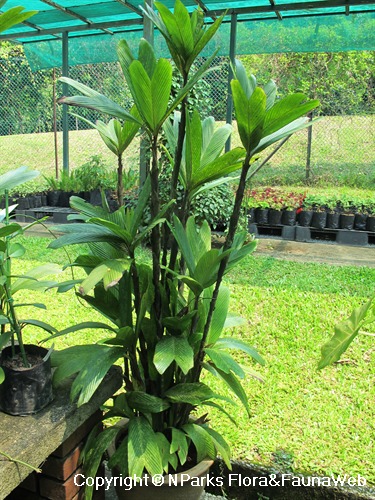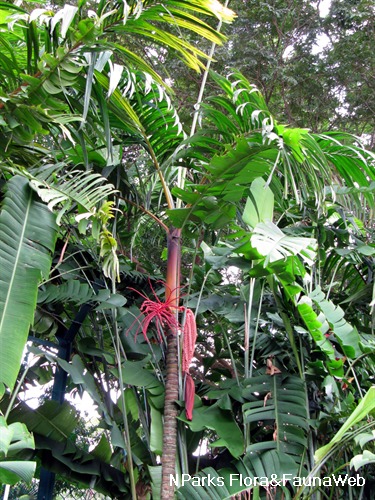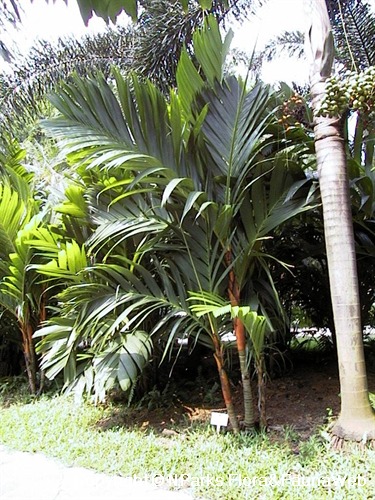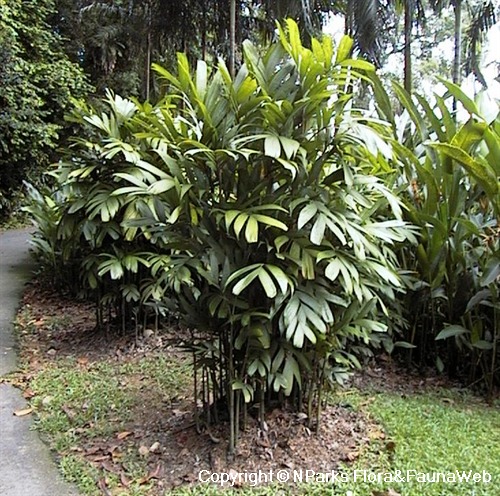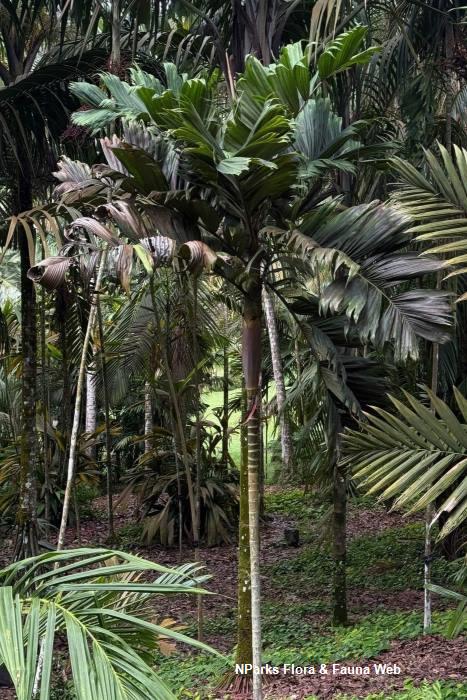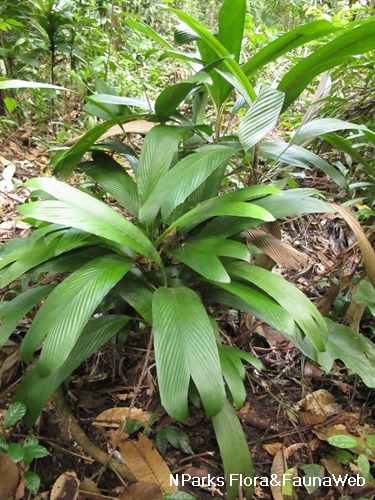
Back
Pinanga simplicifrons (Miq.) Becc.
| Family Name: | Arecaceae (Palmae) |
| Synonyms: | Ptychosperma simplicifrons Miq. |
Name
Classifications and Characteristics
| Plant Division | Angiosperms (Flowering Seed Plants) (Monocotyledon) |
|---|---|
| Plant Growth Form | Palm (Clustered Habit) |
| Lifespan (in Singapore) | Perennial |
| Mode of Nutrition | Autotrophic |
| Plant Shape | Irregular |
| Maximum Height | 1 m |
Biogeography
| Native Distribution | From south east Thailand to Peninsular Malaysia, Singapore and Sumatra |
|---|---|
| Native Habitat | Terrestrial (Primary Rainforest, Freshwater Swamp Forest) |
| Preferred Climate Zone | Tropical |
| Local Conservation Status | Native to Singapore (Critically Endangered (CR)) |
Description and Ethnobotany
| Growth Form | It is a small, clustering, understorey palm, usually less than a metre tall to 1.5 m. Stems are slender, with old persistent leaf sheaths. Its simple (or rarely pinnate) leaves spread radially from the stem. |
|---|---|
| Foliage | Its alternate, stalked, simple (or rarely pinnate) leaves have leaf blades that are oblong, deeply forked at the apex, with prominent veins from the mid rib to the margins, 25–35 cm long. |
| Stems | Its stems are slender, about 8 mm in diameter with overlapping dry leaf sheaths throughout. |
| Crown Shaft | Absent. |
| Flowers | Its small yellow flowers are borne on both sides of a pendulous rachis, 5.5–7 cm long, encased in a rigid leaf sheath. |
| Fruit | Its red fruits are long-ovoid in shaped and slightly curved, 1.8 by 1 cm, arranged in two neat rows along the rachis. |
| Habitat | In wet lowland forests, often on alluvial or periodically freshwater-inundated areas. It occurs locally at Nee Soon Swamp Forest and forests around MacRitchie Reservoir. |
| Associated Fauna | Its flowers are insect pollinated. Fruits are probably bird dispersed. |
| Cultivation | It is propagated by division of the suckers or seeds. |
| Etymology | Malay pinang, vernacular name applied to the betel palm, and members of the Areca, Pinanga and Nenga genera; Latin simplicifrons, simple leaves, referring to the usual undivided leaf fronds of this species |
| Ethnobotanical Uses | Others: It has horticultural potential as an ornamental palm. |
Landscaping Features
| Landscaping | This plant is suitable for planting in cool, moist, shaded areas and is suitable as an indoor plant for its attractive oblong foliage. |
|---|---|
| Desirable Plant Features | Ornamental Foliage, Ornamental Fruits, Ornamental Form |
| Landscape Uses | General, Parks & Gardens, Small Gardens, Interiorscape/ Indoor Plant |
Fauna, Pollination and Dispersal
| Pollination Method(s) | Biotic (Fauna) |
|---|---|
| Seed or Spore Dispersal | Biotic (Fauna) |
Plant Care and Propagation
| Light Preference | Semi-Shade, Full Shade |
|---|---|
| Water Preference | Moderate Water |
| Plant Growth Rate | Moderate |
| Rootzone Tolerance | Moist Soils, Well-Drained Soils, Fertile Loamy Soils |
| Propagation Method | Seed, Sucker |
Foliar
| Foliage Retention | Evergreen |
|---|---|
| Mature Foliage Colour(s) | Green |
| Mature Foliage Texture(s) | Smooth |
| Foliar Type | Simple / Unifoliate |
| Foliar Arrangement Along Stem | Alternate |
| Foliar Attachment to Stem | Petiolate |
| Foliar Shape(s) | Palm Fronds (Simple) |
Floral (Angiosperm)
| Flower Colour(s) | Cream / Off-White |
|---|---|
| Flower Grouping | Cluster / Inflorescence |
| Flower Location | Axillary |
Fruit, Seed and Spore
| Mature Fruit Colour(s) | Red |
|---|---|
| Fruit Classification | Simple Fruit |
| Fruit Type | Fleshy Fruit |
References
| References | Ang, W. F., A. F. S. L. Lok & H. T. W. Tan. 2010. Rediscovery in Singapore of Pinanga simplicifrons (Miq.) Becc. (Arecaceae). Nature in Singapore. 3. 83–86 |
|---|
Image Repository
Others
| Master ID | 30700 |
|---|---|
| Species ID | 5012 |
| Flora Disclaimer | The information in this website has been compiled from reliable sources, such as reference works on medicinal plants. It is not a substitute for medical advice or treatment and NParks does not purport to provide any medical advice. Readers should always consult his/her physician before using or consuming a plant for medicinal purposes. |

